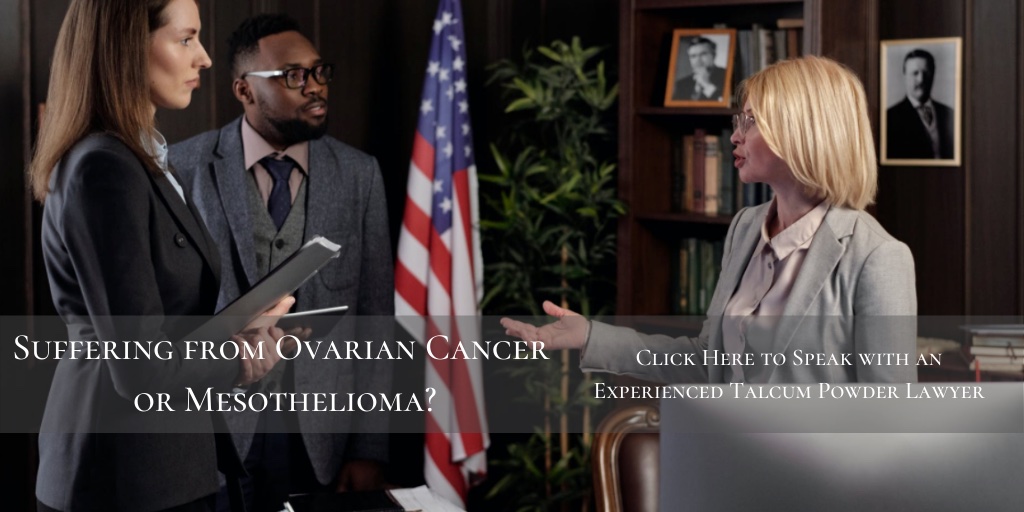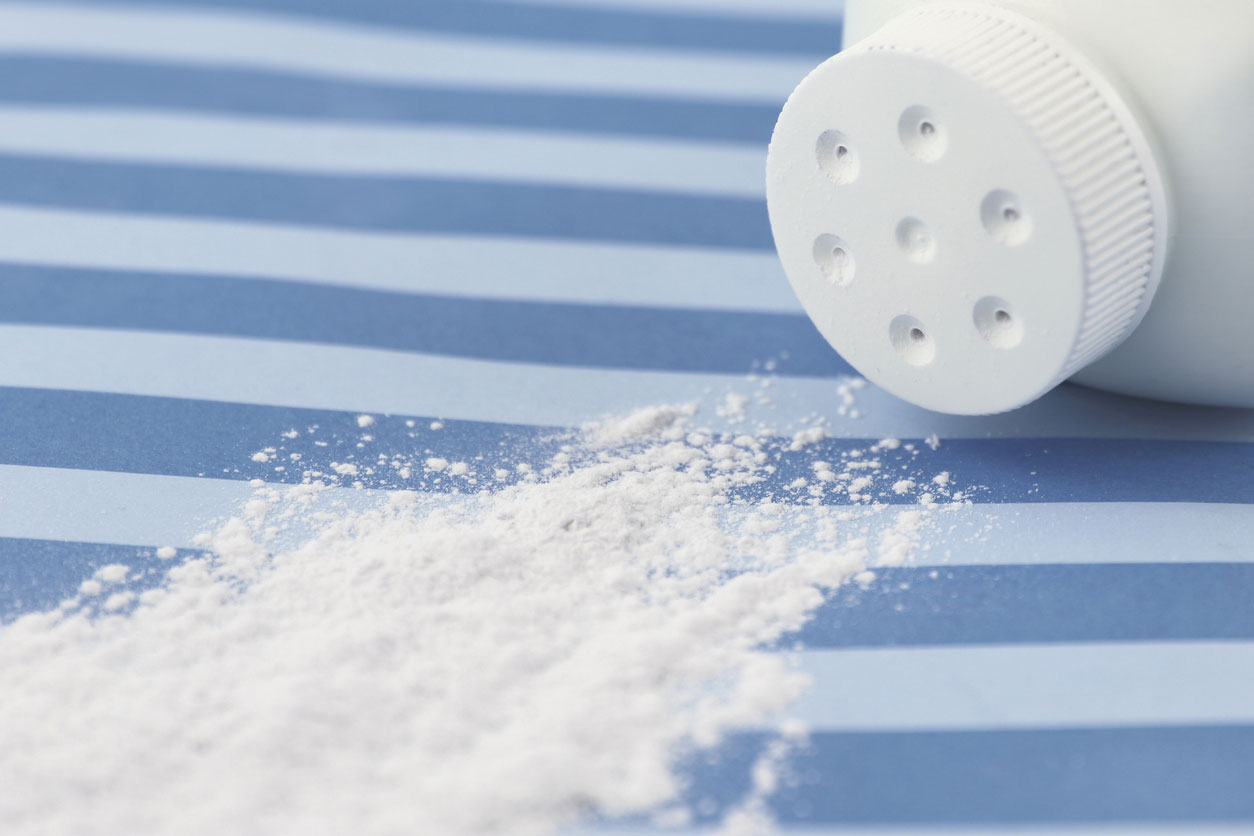Last Updated November 11, 2020
As far back as the 1960s, medical researchers first suggested the possibility that talcum powder sprinkled on female genitalia could be linked with ovarian cancer. Their belief stemmed from the knowledge that talc naturally contains asbestos, a fibrous mineral with a well-established connection to increased cancer risk. Years later, in 1982, scientists conducted the first case-control study to link talcum powder and ovarian cancer. Since then, more and more studies have followed confirming an association with increased risk.
Talc is a naturally occurring mineral that can be crushed, dried, and milled to form a fine, soft, white powder that has a propensity to absorb moisture and reduce friction. Usually, talc is mined in close proximity to deposits of asbestos. Despite the potential for asbestos contamination, talc has been a very popular ingredient in personal care and cosmetic products in the United States for decades. In 1976, in an effort to beat federal and state regulators to the punch, an industry trade association, the Cosmetics, Toiletry and Fragrances Association (CTFA) proposed that the industry be allowed to self-regulate with voluntary standards requiring that all member companies market products which are “free of detectable amounts of asbestos”. “Detectable” is an important distinction as many research experts will contend that even small or virtually undetectable amounts of asbestos can potentially increase cancer risk substantially.
Products such as Johnson & Johnson Baby Powder were aggressively promoted to American consumers for over a century. Originally pitched as a drying and diaper friction solution to mothers for their babies, use of talcum based powder began to wane as parents, concerned with risks from inhalation, switched to other solutions such as corn starch. Accordingly, manufacturers of talcum powders began to switch their marketing focus toward women in general, promoting talcum powder as a solution for genital odors, perspiration, and moisture. Johnson & Johnson even specifically targeted “curvy” and overweight African-American women in its advertising as the use of baby powder underwent a demographic shift. These campaigns were wildly successful and by the mid-2000s, adults accounted for 91% of Johnson’s Baby Powder use.
Despite the studies and evolving knowledge concerning the association between talc-based powders and ovarian cancer, Johnson & Johnson and other manufacturers continue to insist that their talc-based powders are asbestos-free and do not cause cancer. And to be sure, there exists no definitive evidence that talcum powder causes ovarian cancer. Nevertheless, in May 2020, Johnson & Johnson announced that it was discontinuing sales of talc-based powder products in North America. The company will allow existing bottles of baby powder to be sold by retailers until supplies run out.
Evolving Understanding of Ovarian Cancer Risk
The first epidemiologic study involving talcum powder use on female genitalia was performed in 1982 by Dr. Daniel Cramer and his team of researchers. Dr. Cramer’s study found a significantly increased risk of ovarian cancer in women who reported that they regularly used talcum powder in their genital area. According to Dr. Cramer, officials from Johnson & Johnson came to discuss his study. At that time, Dr. Cramer recommended to Johnson & Johnson that they place a warning on its talcum powder about the risk of ovarian cancer. Since the Cramer study, there have been approximately 22 additional epidemiologic studies that have reported an elevated risk for ovarian cancer associated with talcum use on female genitalia. Among these studies and findings:
- In 1993, the U.S. National Toxicology Program (USNTP) published a study on the toxicity of non-asbestiform talc and, according to their statement, found clear evidence of “carcinogenic activity”.
- The International Association for the Research of Cancer (IARC), a unit of the World Health Organization (WHO) published a paper in 2006 wherein it classified perineal use (i.e. in the area of the female genitalia) of talcum based powder as a “Group 2B” human carcinogen. IARC is widely accepted as the international authority on cancer issues.
- The IARC found that between 16-52% of women in the world were using talcum powder to dust their genitals and found that among them there was an increased risk of ovarian cancer ranging from 30-60%.
- The Canadian government classified talc as a “D2A – Very Toxic” cancer-causing substance under its Hazardous Products Act. Notably, asbestos is similarly labeled as D2A.
- The journal “Epidemiology” published the article “The Association Between Talc Use and Ovarian Cancer” in May 2016 which examined the association in 2,041 cases of ovarian cancer and genital talcum powder use. The article concluded with the observation that the use of talcum on the genitals is associated with elevated ovarian cancer risk vs. no increased risk among women who did not use talcum powder on the genitals.
- A study headed up by Joellen M. Schildkraut, Ph.D., MPH, was published in the October 2016 journal “Cancer and Epidemiology, Biomarkers, Prevention”, which indicated that African American women had a substantially higher risk for ovarian cancer if they used talcum to powder their genitalia.
Regulators and the Industry
Manufacturers of talcum powder products are not required to provide safety information in the United States. The U.S. Food and Drug Administration (FDA) has opined in the past that it does not believe it has the authority to require any sort of warning on talcum powder. However, in 2016, the FDA’s Office of Women’s Health (OWH) did announce its funding of additional research into the potential for a relationship between talcum powder and ovarian cancer, acknowledging that its effects on female genitalia have not been adequately investigated. The OWH research is aimed at filling in “data gaps” in the association of talcum powder and the onset of cancerous conditions.
Johnson & Johnson and other talcum-based product manufacturers uniformly continue to insist that their products are both asbestos-free and do not cause cancer. In May 2020, Johnson & Johnson announced that it would discontinue sales of baby powder in North America.
Sources Cited (13):
1) “Asbestos and Cancer Risk” https://www.cancer.org/cancer/cancer-causes/asbestos.html
2) “Estate of Maureen Broderick Milliken, Deceased v. Johnson & Johnson, et al.” Case 2:16-cv-02866-MAK, U.S. District Court, Eastern District of Pennsylvania.
3) “The Association Between Talc Use and Ovarian Cancer” https://journals.lww.com
4) “Association between Body Powder Use and Ovarian Cancer: the African American Cancer Epidemiology Study (AACES)” https://www.ncbi.nlm.nih.gov/pmc/articles/PMC5050086/
5) “Joellen M. Schildkraut, PhD, MPH” https://winshipcancer.emory.edu/bios/faculty/schildkraut-joellen.html
6) “Non-clinical mechanistic studies in addressing ovarian cancer risk from talc use in cosmetics” https://www.fda.gov/science-research/womens-health-research/owh-funded-research-cancer
7) “Cancer Prevention Coalition Letter – November 17, 1994” https://www.reuters.com/investigates/special-report/assets/usa-health-fda-talc/epstein-petition.pdf
8) “JAMA Study Finds No Significant Link Between Talc Powder, Ovarian Cancer” https://www.ajmc.com/view/jama-study-finds-no-link-between-talc-powder-ovarian-cancer
9) “IARC Monographs on the Evaluation of Carcinogenic Risks to Humans” https://monographs.iarc.fr/wp-content/uploads/2018/06/mono93.pdf
10) “Health Canada: Learn about talc and if it’s safe.” https://www.canada.ca/en/health-canada/services/chemicals-product-safety/talc.html
11) “Safety Data Sheet” https://www.gusmerenterprises.com/wp-content/uploads/2015/12/Talc-SDS.pdf
12) “Johnson & Johnson to End Talc-Based Baby Powder Sales in North America” https://www.nytimes.com/2020/05/19/business/johnson-baby-powder-sales-stopped.html
13) “Johnson & Johnson Ends North American Sales of Talc-Based Baby Powder” https://www.cancerhealth.com/article/johnson-johnson-ends-north-american-sales-talcbased-baby-powder



